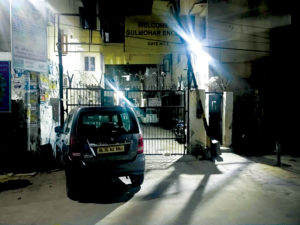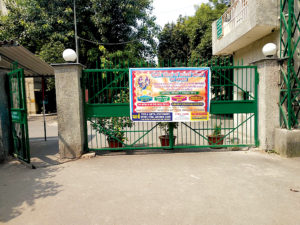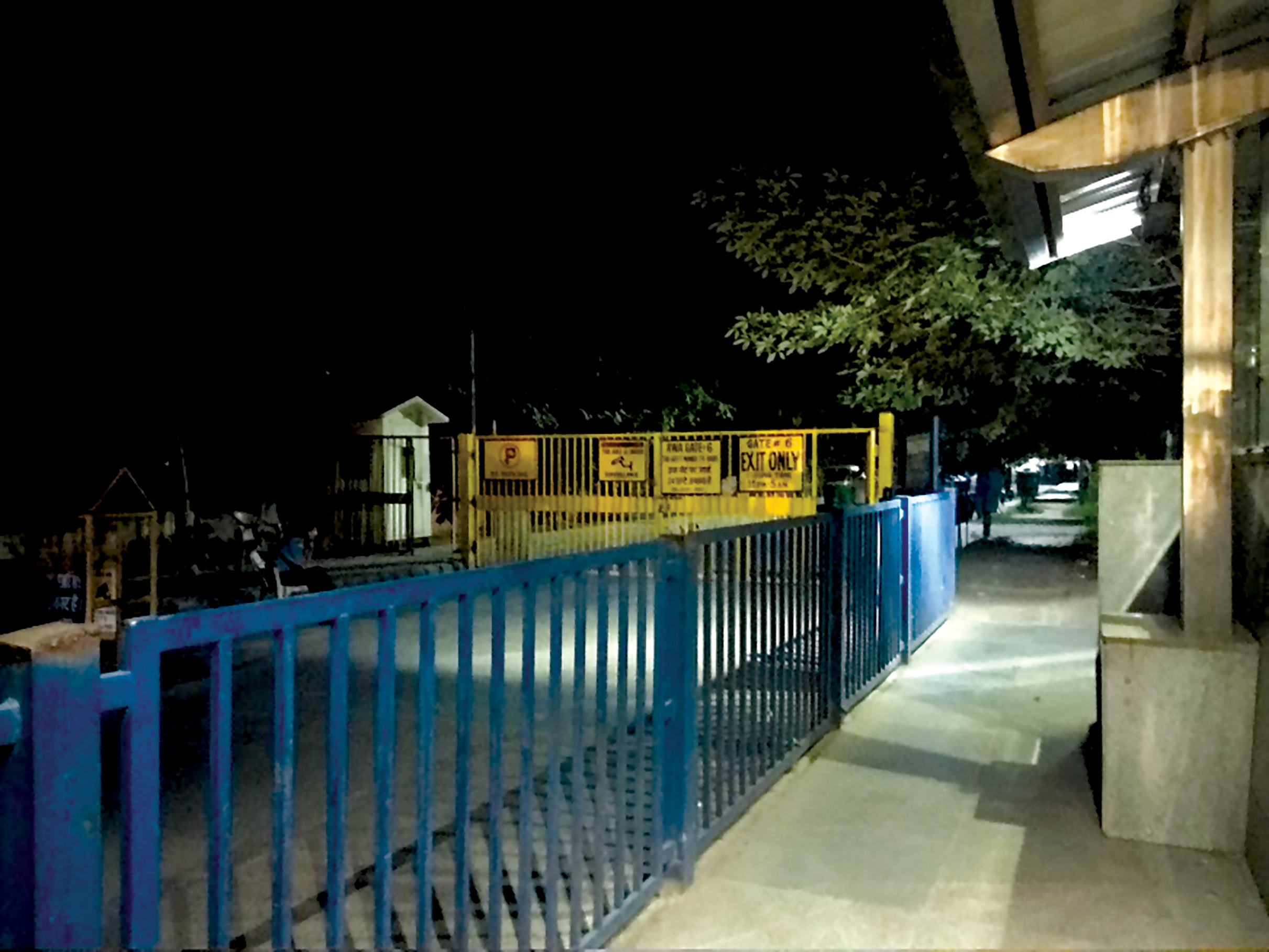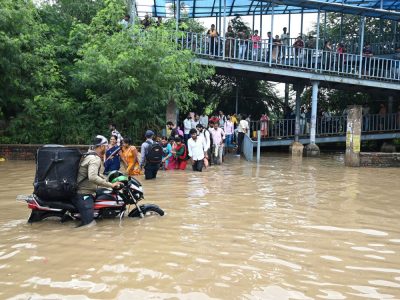South MCD has asked colonies to keep all their gates open 24×7 but many RWAs are flouting the rules, causing discomfort to residents as well as service providers
IN THE good old days, Bhavani Giddu, 49, would walk to her office in Kalkaji area of south Delhi. The office is a kilometre away from her home in Block 3, Kalkaji, and easily accessible from the main road adjacent to her home. She runs a communications agency in the Capital and has been staying in the city for the last five years.
Earlier a resident of Greater Noida, Giddu and her husband chose to live in Delhi due to the proximity to their respective offices. This gated colony, like many others in Delhi, has two gates, one ‘front’ and the other ‘back.’
Until July, both of these gates were open for pedestrians as well as vehicles. There used to be two guards manning both the gates. Giddu would walk to her office, accessing the exit very easily. However, now “it’s been six weeks that the front gate, which is four homes away from my home, remains shut 24×7.”
Oftentimes, Giddu has to travel for work across the country. If she calls a cab, she has to guide the driver to come from the back (the second) gate, because Google Maps would still show a way from the gate which used to be open earlier. Also, it’s easily accessible from Kalkaji intersection.
The hassle she faces today is that even the second gate — the only gate which remains open in daytime, gets shut at 11 in the night, is a 1.5 km from her home. “Therefore, the ease, comfort, convenience and most importantly safety is gone. I may be 49 but that doesn’t mean I’m safe because of my age.”
When she spoke to a member of the Resident Welfare Association, she got a reply that “Chal ke chale jaao na.” (Go by walking). She doesn’t feel safe at night if she has to take another gate, because of the stray dogs in the area. “When I came to Delhi 13 years back, I got bitten by a stray dog the very first day. In my colony there are 30-40 stray dogs.” Earlier she felt safe because of the presence of the guard manning the gate.
When catching a flight, if a cab refuses to take a detour to reach her, she has to walk up to the gate, and reach the main road. “At night the dogs are ferocious, they come bark at you and chase you.” She also adds, in case of an emergency, “an ambulance or a fire brigade will have to go all the way around.”
Residents of the area have devised a way to protest the shutting of the gate. “They drive up to the gate at top speed and honk away. That’s a silly way, though. When nobody comes to open the gate, they take a U-turn and exit from the other gate.”

These locked gates are against the rules. As per provision of Section 320 of DMC Act, “No person shall, except with the permission of the Commissioner, MCD granted in this behalf erect or set up any wall, fence, rail, post, step, booth or other structure whether fixed or movable or whether of permanent or temporary nature, or any fixture in or upon any street or upon or over any open channel, drain, well or tank.”
This circular was issued in 2007, when RWAs filed petitions in the Delhi High Court regarding disputes about installation of iron gates on roads in their colonies. The Court in its 2005 orders directed the commissioner of MCD to formulate bylaws or guidelines pertaining to erection of these gates.
The rules say that gates cannot block lanes/bye-lanes where the right of way of road is upto 18.3 meter. The gate has to be free of any horizontal/vertical obstruction. The gates should not cause unreasonable restrictions on right of way/thoroughfare passing through the colony for access to other areas. Regulation time of entrance/exit from these gates should be available at each gate enabling a person/vehicle to approach the colony easily.
The circular also says that colonies have to inform the MCD about regulation time of entrance/exit from these gates. It also says that RWAs shall supply the information about the details of the security personnel deployed by them at the main and other gates to the local police station and DC zone.
Over the years, almost all the colonies in the Capital city have become fortresses. While some follow the rules by closing the gates as specified in the circular, some do not adhere to the rules.
On a visit to some of the colonies of south Delhi by Patriot, the rule seems to be violated in one way or the other.
In Gulmohar Enclave in Green Park, while some gates remain open before the regulated time starts, some were seen closed. For example, out of the four gates of the DDA colony in the area, only one was seen open — and being guarded, whereas others are permanently shut. Cars are parked in front of the gate.
The colony opposite this DDA colony is dominated by people belonging to a specific community. Kishan Raj, a resident of this area, says, “If we have got any work in the area, then we can only go from one gate. The others remain shut. It’s a task sometimes to get access.”
On a visit to Sarvapriya Vihar in Hauz Khas, this reporter saw a by-lane with a gate which remains shut. A white SUV was parked outside the gate, telling the tale of violation of bylaws.

The main gate of Block D in Saket is a large yellow gate manned by a guard but the gate lies on the main road. The Metro station entrance is adjacent to the gate. Pedestrians walk through the wicket gate. All seems fine — however, it’s not. This gate is also violating the regulated time. At 8 in the night, the gate was seen closed, with the guard opening the gate for each vehicle.
In the case of Swarnim Vihar in Sector 82, Noida, it is fighting a court case along with three other major colonies over two disputed gates. Rajan Sinha, a resident of the area, and acting secretary of the RWA says, “It’s a clash of egos.”
The colonies in the area namely LIG, MIG, HIG and Swarnim Vihar have seen fights happening between the residents over the closure of the two gates. Sinha told Patriot that this is to avoid the back road, leaving only two gates, which lie in Swarnim Vihar, to be used for vehicular movement.
The roads are narrow, and buses ply on the route, creating a safety hazard and hassle for the residents living in Swarnim Vihar. The case has been going on for 14 years without conclusion.
Recently, the South Delhi Municipal Corporation’s direction to Lajpat Nagar-III has led to an uproar from the residents. SDMC has asked police to ensure all 15 gates are kept open. This would facilitate implementation of the parking management plan of Environment Pollution (Prev-ention & Control) Authority.
“We might put this direction to other colonies as well if the current direction turns out to be successful in Lajpat Nagar-III area,” said an official from SDMC who requested anonymity.
The RWAs’ stand on the issue is that the gates were installed for security concerns, and it will not be feasible for them to remain open 24×7.
The very concept of gated communities restricting access to their area can be seen as elitist. “Even when we look at the security guards, they come from marginalised backgrounds. They’re paid a nominal amount of money and mostly have to work double shift to keep these spaces secure. Who is this privacy benefiting? It is only benefitting a certain section of people who can afford it,” says Debomita Mukherjee, a Researcher in Sociology at University of Hyderabad.
She opines, “Gated communities are extremely class-based communities, except the government ones. If you come from a certain upper caste or dominant caste background then your access to that land is higher. Because you can pay the money. But the person who works in those areas, they are not getting the same security as you are.”





